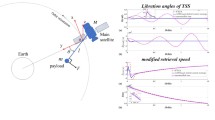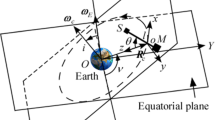Abstract
For mitigating the libration angle fluctuation of the tethered satellite system, this paper discusses how to make the uniform velocity–deceleration separation scheme achieve the best effect. First, a judgment condition is established to determine the tether state by comparing the tether length and the relative distance of the sub-satellite and the parent satellite. Based on the tethered satellite system dynamics equation and Clohessy–Wiltshire equation, dynamic models are given for four cases of tether states. Second, the influence of the uniform velocity–deceleration separation scheme on the libration angle is analyzed by taking the libration angle at the separation ending time and the mean absolute value of the libration angle as index functions. Then, the optimality problem of the uniform velocity–deceleration separation scheme is formulated as an optimization problem with constraints, and an approximate solution algorithm is given by combining the back propagation neural network and Newton–Raphson method of multiple initial values. Finally, the effectiveness of the proposed method is verified by a numerical simulation.















Similar content being viewed by others
Data Availability
The data that support the findings of this study are available upon request from the corresponding author guojin@ustb.edu.cn.
References
Zhu, R., Misra, A., & Modi, V. (1994). Dynamics and control of coupled orbital and librational motion of tethered satellite systems. The Journal of the Astronautical Sciences, 42(3), 319–342.
Giuseppi, A., Delli Priscoli, F., & Pietrabissa, A. (2022). Robust and fault-tolerant spacecraft attitude control based on an extended-observer design. Control Theory and Technology, 20, 323–337. https://doi.org/10.1007/s11768-022-00101-2
Haghighi, R., & Pang, C. (2016). Energy-efficient control of nanosatellites during distributed region formation flying. Control Theory and Technology, 14, 263–278. https://doi.org/10.1007/s11768-016-6075-9
Tan, S., Guo, J., Zhao, Y., & Zhang, J. (2021). Adaptive control with saturation-constrainted observations for drag-free satellites-a set-valued identification approach. Science China Information Sciences, 64(10), 202202. https://doi.org/10.1007/s11432-020-3145-0
Yang, F., Tan, S., Xue, W., Guo, J., & Zhao, Y. (2020). Extended state filtering with saturation-constrainted observations and active disturbance rejection control of position and attitude for drag-free satellites. Acta Automatica Sinica, 46(11), 2337–2349. https://doi.org/10.16383/j.aas.c190515
Hu, Y., Guo, J., Meng, W., Liu, G., & Xue, W. (2022). Longitudinal control for balloon-borne launched solar powered UAVs in near-space. Journal of Systems Science and Complexity, 35, 802–819. https://doi.org/10.1007/s11424-022-1302-6
Lu, K., Liu, H., Zeng, L., Wang, Z., Zhang, Z., & An, J. (2023). Applications and prospects of artificial intelligence in covert satellite communication: a review. Science China Information Sciences, 66(2), 121301. https://doi.org/10.1007/s11432-022-3566-4
Johnson, L., Gilchrist, B., Estes, R., & Lorenzini, E. (1999). Overview of future NASA tether applications. Advances in Space Research, 24(8), 1055–1063. https://doi.org/10.1016/S0273-1177(99)00553-0
Sanmartín, J., Martinez-Sanchez, M., & Ahedo, E. (1993). Bare wire anodes for electrodynamic tethers. Journal of Propulsion and Power, 9(3), 353–360. https://doi.org/10.2514/3.23629
Fuhrhop, K. (2007). Theory and experimental evaluation of electrodynamic tether systems and related technologies. Ph.D. thesis. Ann Arbor, MI, USA: University of Michigan. https://hdl.handle.net/2027.42/57663.
Avanzini, G., & Fedi, M. (2013). Refined dynamical analysis of multi-tethered satellite formations. Acta Astronautica, 84, 36–48. https://doi.org/10.1016/j.actaastro.2012.10.031
Colombo, G., Gaposchkin, E., Grossi, M., & Weiffenbach, G. (1975). The skyhook: A shuttle-borne tool for low-orbital-altitude research. Meccanica, 10, 3–20. https://doi.org/10.1007/BF02148280
Bilén, S., Gilchrist, B., Bonifazi, C., & Melchioni, E. (1995). Transient response of an electrodynamic tether system in the ionosphere: TSS-1 first results. Radio Science, 30(5), 1519–1535. https://doi.org/10.1029/95RS01889
Hill, M., Calhoun, R., Fernando, H., & Wieser, A. (2010). Coplanar doppler lidar retrieval of rotors from T-REX. Journal of the Atmospheric Sciences, 67(3), 713–729. https://doi.org/10.1175/2009JAS3016.1
Iki, K., Kawamoto, S., Ohkawa, Y., Okumura, T., Kawashima, K., Takai, M., Izawa, K., Matsumoto, K., Suzuki, S., Katayama, Y., Horikawa, Y., & Inoue, K. (2016). Expected on-orbit tether deployment dynamics on the KITE mission. Transactions of the Japan Society for Aeronautical and Space Sciences, Aerospace Technology Japan, 14(30), 9–18. https://doi.org/10.2322/tastj.14.Pr_9
Cartmell, M., & Mckenzie, D. (2008). A review of space tether research. Progress in Aerospace Sciences, 44(1), 1–21. https://doi.org/10.1016/j.paerosci.2007.08.002
Chen, Y., Huang, R., He, L., Ren, X., & Zheng, B. (2014). Dynamical modelling and control of space tethers: a review of space tether research. Nonlinear Dynamics, 77(4), 1077–1099. https://doi.org/10.1007/s11071-014-1390-5
Beletskii, V., & Pivovarov, M. (2000). The effect of the atmosphere on the attitude motion of a dumb-bell-shaped artificial satellite. Journal of Applied Mathematics and Mechanics, 64(5), 691–700. https://doi.org/10.1016/S0021-8928(00)00097-6
Burov, A., & Kosenko, I. (2015). Planar oscillations of a dumb-bell of a variable length in a central field of Newtonian attraction. exact approach. International Journal of Non-Linear Mechanics, 72, 1–5. https://doi.org/10.1016/j.ijnonlinmec.2015.01.011
Yu, B., Dai, P., & Jin, D. (2018). Modeling and dynamics of a bare tape-shaped tethered satellite system. Aerospace Science and Technology, 79, 288–296. https://doi.org/10.1016/j.ast.2018.05.046
Liu, C., Chen, S., Guo, Y., & Wang, W. (2023). Robust adaptive control for rotational deployment of an underactuated tethered satellite system. Acta Astronautica, 203, 65–77. https://doi.org/10.1016/j.actaastro.2022.11.025
Chu, Z., Di, J., & Cui, J. (2018). Hybrid tension control method for tethered satellite systems during large tumbling space debris removal. Acta Astronautica, 152, 611–623. https://doi.org/10.1016/j.actaastro.2018.09.016
Bourabah, D., & Botta, E. (2022). Length-rate control for libration reduction during retraction of tethered satellite systems. Acta Astronautica, 201, 152–163. https://doi.org/10.1016/j.actaastro.2022.08.037
Su, B., Zhang, F., & Huang, P. (2021). Robust control of triangular tethered satellite formation with unmeasured velocities. Acta Astronautica, 186, 190–202. https://doi.org/10.1016/j.actaastro.2021.04.045
Shan, M., & Shi, L. (2022). Velocity-based detumbling strategy for a post-capture tethered net system. Advances in Space Research, 70(5), 1336–1350. https://doi.org/10.1016/j.asr.2022.06.012
Vadali, S. (1991). Feedback tether deployment and retrieval. Journal of Guidance, Control, and Dynamics, 14(2), 469–470. https://doi.org/10.2514/3.20662
Wen, H., Zhu, Z., Jin, D., & Hu, H. (2016). Space tether deployment control with explicit tension constraint and saturation function. Journal of Guidance, Control, and Dynamics, 39(4), 916–921. https://doi.org/10.2514/1.G001356
Fujii, H., & Ishijima, S. (1989). Mission function control for deployment and retrieval of a subsatellite. Journal of Guidance, Control and Dynamics, 12(2), 243–247. https://doi.org/10.2514/3.20397
Li, X., Sun, G., Han, S., & Shao, X. (2021). Fractional-order nonsingular terminal sliding mode tension control for the deployment of space tethered satellite. IEEE Transactions on Aerospace and Electronic Systems, 57(5), 2759–2770. https://doi.org/10.1109/TAES.2021.3061815
Clohessy, W., & Wiltshire, R. (1960). Terminal guidance system for satellite rendezvous. Journal of the Aerospace Science, 27, 653–674. https://doi.org/10.2514/8.8704
Tan, D., & Chen, Z. (2012). On a general formula of fourth order Runge–Kutta method. Journal of Mathematical Science and Mathematics Education, 7(2), 1–10.
Butcher, J. (1996). A history of Runge–Kutta methods. Applied Numerical Mathematics, 20(3), 247–260. https://doi.org/10.1016/0168-9274(95)00108-5
Guo, J., Jia, R., Su, R., & Zhao, Y. (2023). Identification of fir systems with binary-valued observations against data tampering attacks. IEEE Transactions on Systems, Man, and Cybernetics: Systems, 53(9), 5861–5873. https://doi.org/10.1109/TSMC.2023.3276352
Guo, J., & Diao, J. (2020). Prediction-based event-triggered identification of quantized input fir systems with quantized output observations. Science China Information Sciences, 63, 112201–111220112. https://doi.org/10.1007/s11432-018-9845-6
Guo, J., Wang, X., Xue, W., & Zhao, Y. (2021). System identification with binary-valued observations under data tampering attacks. IEEE Transactions on Automatic Control, 66(8), 3825–3832. https://doi.org/10.1109/TAC.2020.3029325
Xie, Y., & Ma, C. (2011). A smoothing Levenberg–Marquardt algorithm for solving a class of stochastic linear complementarity problem. Applied Mathematics and Computation, 217(9), 4459–4472. https://doi.org/10.1016/j.amc.2010.10.049
Zhang, Y., Jiang, X., Bai, Z., Guo, J., & Wei, C. (2022). Dynamics and rebound behavior analysis of flexible tethered satellite system in deployment and station-keeping phases. Defence Technology, 18(3), 509–523. https://doi.org/10.1016/j.dt.2021.04.007
Luo, L., Li, A., & Wang, C. (2014). Simulation analysis of orbital parameters of small satellite launching by space tether system. In: Proceedings of the 33rd Chinese Control Conference, pp. 6398–6402. https://doi.org/10.1109/ChiCC.2014.6896042.
Ji, Z., & Shi, G. (2023). Adaptive neural dynamics-based speed control strategy for stable retrieval of tethered satellite system. Advances in Space Research, 71(12), 4987–4994. https://doi.org/10.1016/j.asr.2023.01.061
Author information
Authors and Affiliations
Corresponding author
Ethics declarations
Conflict of interest
The authors declare that there is no competing financial interest or personal relationship that could have appeared to influence the work reported in this paper.
Additional information
This research was supported by the National Key R &D Program of China (2018YFA0703800), the National Natural Science Foundation of China (62173030) and the Beijing Natural Science Foundation (4222050).
Rights and permissions
Springer Nature or its licensor (e.g. a society or other partner) holds exclusive rights to this article under a publishing agreement with the author(s) or other rightsholder(s); author self-archiving of the accepted manuscript version of this article is solely governed by the terms of such publishing agreement and applicable law.
About this article
Cite this article
Yu, P., Zhang, JF., Tan, S. et al. On the optimality of uniform velocity–deceleration separation scheme for tethered satellite systems. Control Theory Technol. (2024). https://doi.org/10.1007/s11768-024-00221-x
Received:
Revised:
Accepted:
Published:
DOI: https://doi.org/10.1007/s11768-024-00221-x




